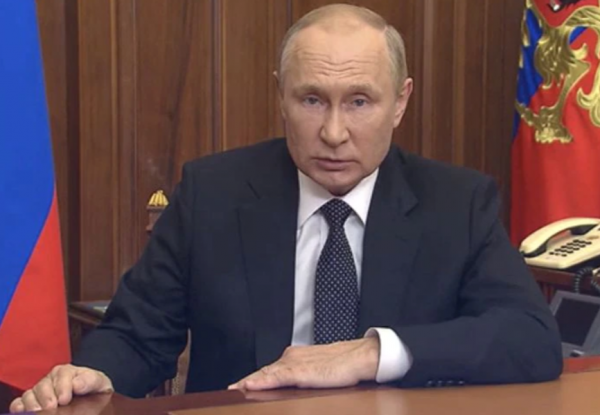Vladimir Putin, in an unhinged and wildly threatening speech, informed his nation that he was calling up 300,000 “reservists” for, presumably, service in Ukraine.
There is a lot more to this mobilization to which he did not speak.
In the same speech, he threatened the use of nuclear weapons ensuring the world he was “not bluffing.” He has done this more than once before.
The Russian Army
The Russian Army was more than 4MM soldiers at the time of the dissolution of the USSR, a happening that is at the core of Putin’s maniacal attempt to rekindle the grandeur of that time.
Oh, please, Vlad, Russia’s economy is 25% smaller than Italy’s for goodness sake.
The Russians cannot afford such an expensive army today.
The current Russian military is subdivided as follows:
1. Three “branches” — the General Forces (army), the Navy and the Aerospace Forces (air force and aerospace meaning drones and satellites)
2. Two “strategic troop branches” — Strategic Rocket Forces and Airborne Forces (paratroopers)
3. Special Operations Forces
4. Logistical Support
In addition, the Russians field a National Guard and Border Security Forces. These last two elements are not under the control of the general staff — they report to the President of Russia.
The Border Security Forces is the paramilitary element of the FSS (the main Russian intel unit, the Federal Security Service).
Today, the Russian Army is less than 1.5MM — there is authority indicating it is less than a million. I believe it to be less than 1MM based on my own research.
The Russian Soldier
The Russian soldier is historically notorious for being tough in the field, a reputation gained during World War II fighting against actual Nazi invaders.
While that legend remains, this Russian army is not that Russian army of World War II.
The Russian army is constructed about a core of “professional” soldiers and a big helping of conscripts. The ratio is about 35% professionals to 65% conscripts.
Professionals receive a small wage and conscripts virtually nothing. Being drafted in Russia is highly unpopular and thus it is usually the “dead enders” who end up in the Russian army.
The Russian draft is replete with deferments and ways to dodge it.
There is massive hazing in the Russian army and a goodly number of Russian conscripts die annually.
It says something about the quality of Russian officer leadership that they turn a blind eye toward such brutality.
Conscription
If a Russian between the age of 18 and 27 is conscripted, he will serve for 12 months and thereafter be relegated to the “reserves” until advanced age.
It is this pool of former conscripts that is being tapped again by Putin.
In the Russian conscript’s first 4 months of service, he is trained. Compare that to American basic training and advanced individual training that can last a total of more than a year.
Putin’s mobilization order
Putin’s order is for up to 1,200,000 conscripts of which 300,000 are being drawn immediately. The pool of conscripts — men who served their one year through earlier conscription — is about 2,000,000, so this is quite a leap.
The conscription has begun in far flung places first — Siberia, Crimea, small towns in the hinterlands — and is ill received in larger cities such as Moscow.
Putin does not want to trigger unrest and protests — which are happening anyway — in Moscow. It is my hope that this is the beginning of Putin’s fall from power.
Nobody is enthusiastic about being drafted a second time and nobody is enthusiastic about going to war unwillingly in Ukraine.
So what happens now, Big Red Car?
Here are several observations:
1. It may all be too little too late. Right now it does not look like these conscripts can fill out mauled Russian units in sufficient time to forestall the Ukrainian counterattack.
There is a real chance that matters in the field will be decided by Christmas and it is unlikely these new Russian troops can be anything other than a dribble by then.
2. These conscripts are not quality, motivated soldiers.
They will not be officers, NCOs or leaders. They will be riflemen, cannon cockers, combat arms soldiers, and cannon fodder.
Note that Russian losses — up to 100K — are predominantly in units that saw action, combat arms units such as infantry, armor, artillery, engineers. The replacements will be sent where the losses were sustained.
The Russians have lost a lot of small unit leaders and these conscripts will not fill that gap.
3. Soldiering is a young man’s game and these will not be young men. The pool of conscripts is thought to be as many as 2,000,000 spread over an age range from 20 – 59.
These conscripts X 2 will be old, fat, out of shape, smokers, drinkers, and drawn from the bottom of the barrel.
4. The Russians — the Orcs — are facing a battle hardened Ukrainian army that is progressively better equipped and flush with victory and whose generals have outperformed their adversaries.
They have rounded into battle ready, smart combat shape and are highly motivated to defend their homeland. These seemingly intangible qualities are vital.
5. The Russian army is caught in a classic squeeze — manpower, material, motivation, and external support. They are screwed and they deserve it.
Bottom line it, Big Red Car
Putin is playing his second to last card with this mobilization which, in my view, is too late and of inferior quality.
All Jolly Vlad has left is the nuclear card. That is not good, but we shall see.
But, hey, what the Hell do I really know anyway? I’m just a Big Red Car.

This clown thought his army could take Kyiv and topple the Ukrainian government in three days. Huge miscalculation. He is now directing his field commanders personally. Amateur hour.

